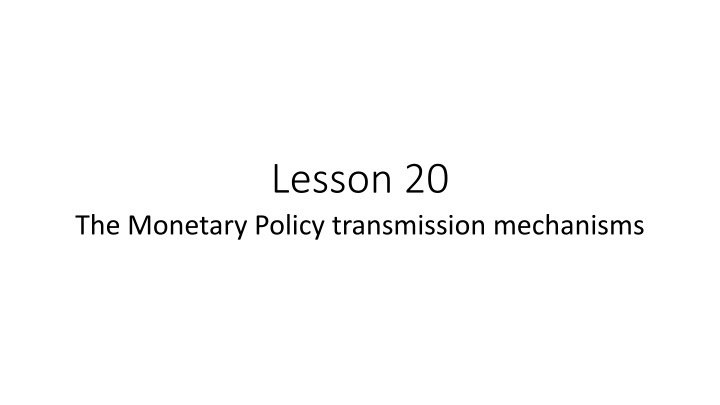
Monetary Policy Transmission Mechanisms
Explore the various channels through which monetary policy impacts the economy, including the Interest Rate Channel, Asset Price Channel, Exchange Rate Channel, and Credit Channel. Learn how changes in interest rates, asset prices, and exchange rates influence investment, consumption, and overall economic output.
Uploaded on | 0 Views
Download Presentation

Please find below an Image/Link to download the presentation.
The content on the website is provided AS IS for your information and personal use only. It may not be sold, licensed, or shared on other websites without obtaining consent from the author. If you encounter any issues during the download, it is possible that the publisher has removed the file from their server.
You are allowed to download the files provided on this website for personal or commercial use, subject to the condition that they are used lawfully. All files are the property of their respective owners.
The content on the website is provided AS IS for your information and personal use only. It may not be sold, licensed, or shared on other websites without obtaining consent from the author.
E N D
Presentation Transcript
Lesson 20 The Monetary Policy transmission mechanisms
Channels of transmission of monetary policy The Interest Rate Channel The Asset Price Channel The Exchange Rate Channel The Credit Channel
The Interest Rate Channel It Keynesian model. The traditional Keynesian view of how a monetary tightening is transmitted to the real economy can be synthetized in a schematic representation, i M r I Y a contractionary monetary policy is conducted through the increase in money interest rate, in turn causing a reduction of money in circulation. This leads via the reduction of prices - to a rise in real interest rates which in turn raises the cost of capital, thereby causing a decline in investment spending, thereby leading to a decline in aggregate demand and a fall in output is the key monetary transmission mechanism in the basic
The Asset Price Channel I Tobin s q MVF q = RCC where MVF = market value of firms and RCC = replacement cost of capital. If q is high, MFV is high relative to RCC, and new plant and equipment capital is cheap relative to the market value of firms. In this case, companies can issue stock and get a high price for it Perelative to the cost of the facilities and equipment they are buying. I because firms can buy a lot of new investment goods with only a small issue of stock The transmission mechanism in case of an expansionary monetary policy is i M Pe q I Y
The Asset Price Channel II The wealth effect According to the life-cycle consumption theory, consumption depends also on wealth. A major component of financial wealth is common stocks. When stock prices fall, the value of financial decreases, thus decreasing the lifetime resources of consumers, and consumption should fall. Since we have already seen contractionary monetary policy can lead to a decline in stock prices (Pe) another monetary transmission mechanism is (in case of a tightening) : wealth that i M Pe wealth consumtion Y
Exchange rate channel An increase in interest rates makes domestic deposits more attractive relative to deposits denominated in foreign currencies, leading to a rise in the value of the national currency (appreciation of the exchange rate E) The higher value of the domestic currency makes domestic goods more expensive than foreign goods, thereby causing a fall in net exports NX and hence in aggregate output. The schematic for the monetary transmission mechanism operating through the exchange rate is thus: i M E NX Y This mechanism works through the uncovered interest parity (UIP)
Credit channel I Bank lending channel The bank lending channel is based on the view that banks play a special role in the financial system because they are especially well suited to deal with certain types of borrowers, especially small firms where the problems of asymmetric information can be especially pronounced. i M bank loans I Y
Credit channel II Balance-sheet channel The balance-sheet channel operates through the net worth of business firms. Lower net worth means that lenders have less collateral for their loans, and so losses from adverse selection are higher. Lower net worth of business firms also increases the moral hazard problem because it means that owners have a lower equity stake in their firms, giving them more incentive to engage in risky investment projects. Contractionary monetary policy, which causes a decline in equity prices along lines described earlier, lowers the net worth of firms and so leads to lower investment spending and aggregate demand because of the increase in adverse selection and moral hazard problems. i M Pe moral hazard adverse selection I Y






















